Author Introduction: Yan Hanbing, PhD, Professor, Doctoral Supervisor, East China Normal University, Open Education College (Shanghai 200062); Wang Wei, Master’s Student, East China Normal University, Department of Educational Information Technology (Shanghai 200062).
Funding Project: Major Project of National Social Science Fund for 2018 “Information Technology Promotes Fairness in Basic Education in the New Era” (18ZDA335).
Citation: Yan Hanbing, Wang Wei (2020). Comparative Analysis and Optimization of STEM Curriculum Quality from the Perspective of Interdisciplinary Integration. Modern Distance Education Research, 32(2):39-47.
Abstract: The continuous development of STEM education has created an urgent demand for interdisciplinary integrated courses. However, the current construction of STEM courses in China focuses more on formal specifications, with overall quality being concerning. Therefore, developing high-quality STEM courses from an interdisciplinary integration perspective to guide teaching is imperative. Comparison and reference are important ways to improve quality and efficiency. To enhance the quality of STEM course construction in China, we draw on authoritative STEM course integration evaluation tools to qualitatively and quantitatively compare and analyze 58 outstanding domestic and foreign STEM course cases across nine dimensions: course context, engineering design challenges, integration of scientific content, integration of mathematical content, teaching strategies, teamwork, communication, assessment, and organization. The findings reveal significant shortcomings in domestic STEM course cases compared to foreign STEM courses in terms of course context, integration of scientific content, teaching strategies, and assessment. This, to some extent, restricts the construction of STEM courses and the improvement of teaching quality in China. In the future, the construction of STEM courses in China should strengthen the following four aspects: first, enhance responsiveness to social issues and cultivate students’ sense of social responsibility; second, encourage effective failure and create authentic scientific experiences; third, enrich student-centered strategies and amplify students’ cognitive processes; fourth, focus on informal assessment to promote the development of students’ comprehensive abilities.
Keywords: STEM Curriculum; Quality Assessment; Analytical Framework; Comparative Research; Interdisciplinary Integration
In 1986, the National Science Board (NSB) of the United States published “Science, Mathematics, and Engineering Education in Undergraduate Education,” which first explicitly proposed the programmatic suggestion of “integrating science, mathematics, engineering, and technology education,” considered the beginning of STEM education (Zhong Baichang et al., 2014). STEM is an acronym for Science, Technology, Engineering, and Mathematics, but it is not merely a simple combination of these four disciplines. Different scholars have different understandings of STEM education, with two main viewpoints currently: one believes that STEM is a curriculum that solves real-world problems through purposeful integration of different disciplines (Labov et al., 2010), while the other views STEM as a learning method that cultivates learners’ comprehensive use of STEM knowledge to solve real-world problems (Fu Qian et al., 2016). Although scholars emphasize different aspects of the definition of STEM education, they all point to the interdisciplinary core feature of STEM education, which is to cultivate compound innovative talents and well-rounded individuals through a multidisciplinary cross-integration approach (Yu Shengquan et al., 2015).
The curriculum is key to implementing STEM education. To promote STEM education, scholars at home and abroad have conducted research on STEM courses at various levels. In terms of curriculum design, Zhou Pengqin et al. (2016) analyzed the characteristics of the teaching content of American science curriculum materials “SCIENCE RESOURCES” from the STEM perspective. Yang Yanjun et al. (2019) analyzed the characteristics of the STEM curriculum of the Mars education project at Arizona State University through qualitative analysis methods from the aspects of teaching strategies and curriculum development strategies. Regarding teaching effectiveness, Selwitz et al. (2018) used qualitative methods to analyze STEM courses from the perspectives of students’ opinions and viewpoints to better understand the extent to which STEM courses meet students’ needs and further improve the curriculum. In terms of disciplinary characteristics, Parker et al. (2015) constructed a quality assessment framework for technology application in STEM classrooms from a technological perspective, including the types of technology used, consistency with STEM practices, student-centered teaching practices, and relevance to real-world environments. Although the aforementioned studies have qualitatively or quantitatively analyzed STEM courses from different perspectives, there has been no research that evaluates and compares the quality of outstanding domestic and foreign STEM course cases from the perspective of interdisciplinary integration. This study aims to evaluate and compare the quality of domestic and foreign STEM courses to accurately identify the problems existing in China’s STEM courses and provide guiding suggestions.
1. Case Sources and Standards
The National Science Teachers Association (NSTA) is the largest organization in the world dedicated to promoting science teaching and excellence in innovation. The NSTA hosts three magazines: “Science and Children,” “Science Scope,” and “The Science Teacher,” which regularly publish outstanding STEM courses aimed at elementary, middle, and high school science teachers, showcasing successful cases of American teachers in science and engineering education. This study selected 32 cases with complete teaching designs that reflect STEM teaching characteristics from these three magazines published from January 2016 to December 2018 as foreign analysis samples, covering elementary (11), middle (13), and high school (8) levels.
On August 14, 2017, the second STEM+ Innovation Education Academic Exchange Seminar, hosted by the High-Precision Innovation Center for Future Education at Beijing Normal University and organized by Jiangxi Education Publishing House, discussed activity design, curriculum development, and innovation sharing around STEM+ teaching achievements, gathering many outstanding STEM course cases. The conference selected 26 practical teaching cases from frontline teachers in China, which were included in the collection, covering elementary (16), middle (6), and high school (4) levels. These course cases come from more than ten cities, including Beijing, Hangzhou, Guangzhou, Chongqing, and Wuhan, representing a broad regional coverage and real teaching experiences from frontline teachers, thus serving as domestic analysis samples for this study.
2. Case Analysis Framework
To assess 20 engineering design-based STEM curriculum units developed by teachers in professional development projects, Guzey et al. developed the STEM Integration Curriculum Assessment (STEM-ICA), which includes nine dimensions: course context, engineering design challenges, integration of scientific content, integration of mathematical content, teaching strategies, teamwork, communication, assessment, and organization. This provides important references for evaluating the interdisciplinary characteristics of a curriculum (Guzey et al., 2016). Since the STEM-ICA was initially designed to assess teachers’ performance improvements in professional development projects, focusing on engineering design-based STEM courses, it has certain limitations. Additionally, the STEM-ICA assessment tool consists of a series of yes/no questions aimed at helping assessors reflect on the specific elements of the curriculum unit and understand the evaluation intentions of each dimension, which strictly speaking does not form a clear curriculum evaluation framework. This study further refines the evaluation criteria based on the questions set in the STEM-ICA assessment tool and makes slight adjustments in reference to the “Next Generation Science Standards (NGSS)” and the “State Common Core Curriculum Standards – Mathematics (CCSS-M),” such as adding the requirement of “using appropriate tools/unit systems to collect, process, and represent data” in the dimension of “integration of mathematical content,” ultimately forming the STEM course integration evaluation indicators as shown in Table 1.
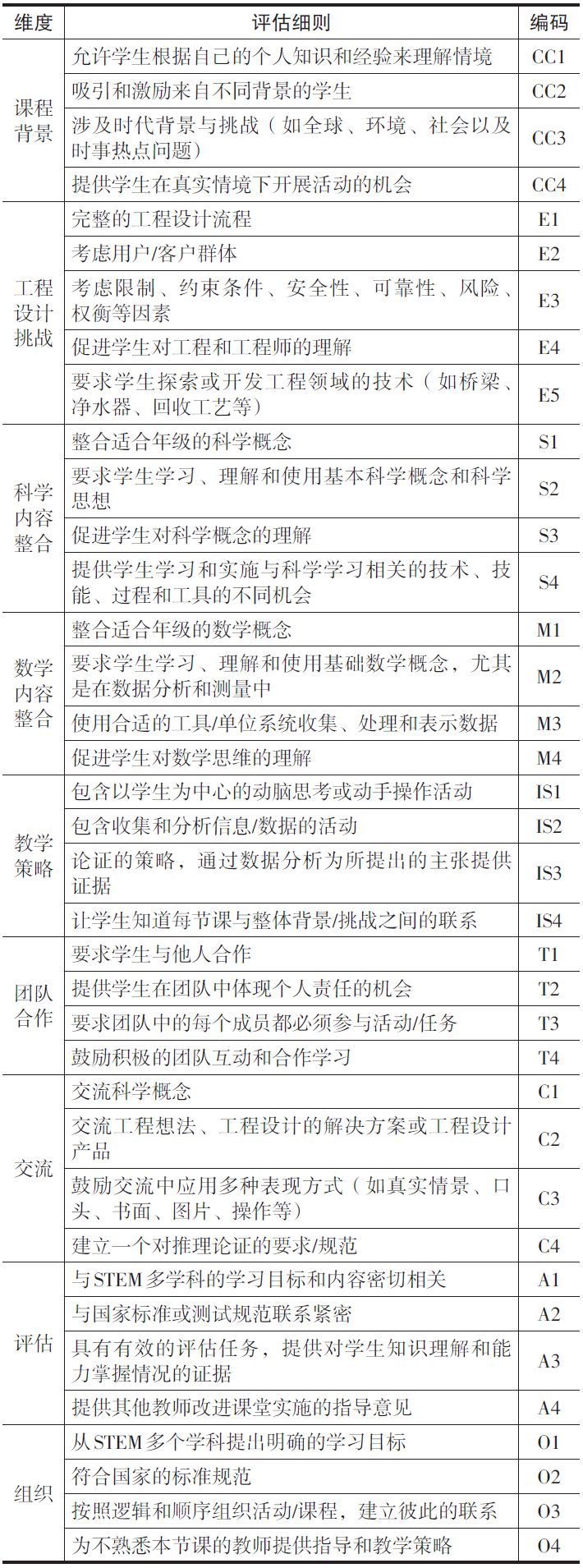
The STEM course integration evaluation indicators consist of nine dimensions, with each dimension containing 4 to 5 evaluation criteria, totaling 37 evaluation criteria. Based on the evaluation indicators, the specific scoring rules are as follows: to make the scoring results easier to understand, this study adopts a scoring method of 1 to 5 points, with the initial score for each dimension being 1 point. For each evaluation criterion reflected, the corresponding dimension score increases by 1 point, with a maximum score of 5 points for each dimension (i.e., if the “engineering design challenges” dimension meets 4 to 5 evaluation criteria, the score for that dimension is full marks of 5 points). The overall score of the course is the weighted average of the scores for each dimension. In addition, for subsequent comparative analysis of domestic and foreign STEM course cases, the study also coded whether the evaluation criteria were reflected in the course cases (if the evaluation criteria were reflected in the case, the code is 1; if not, the code is 0). Combining quantitative statistics and qualitative analysis helps further illustrate the research results.
3. Research Questions
This study adopts a qualitative and quantitative combined research method, first thoroughly reviewing the selected course cases to gain a preliminary understanding of the overview of domestic and foreign STEM courses. Secondly, based on the selected case analysis framework, a five-point Likert scale is used to score 58 outstanding STEM course cases across nine dimensions: course context, engineering design challenges, integration of scientific content, integration of mathematical content, teaching strategies, teamwork, communication, assessment, and organization, and statistical analysis of the scores for each dimension. Finally, it compares the scoring results of domestic and foreign STEM course cases, and combines typical samples for in-depth analysis to explore the following three questions: (1) How is the overall quality of domestic and foreign STEM courses? How do they perform in each dimension? (2) In which dimensions do domestic STEM courses have significant deficiencies? What are the reasons? (3) What insights can the American STEM course cases provide for the construction of STEM courses in China?
4. Reliability Analysis
To ensure the external reliability of data analysis, this study conducted reliability analysis. Two scoring groups were formed by four researchers familiar with STEM education (two in each group), who independently scored five domestic and five foreign cases after clarifying the case analysis framework, and then discussed within the group to finalize their scoring results. Through the consistency test of the scorers, a Kendall’s W coefficient of 0.749 (P<0.05) was obtained. Therefore, it can be concluded that the evaluation results of the four researchers have a high degree of consistency, indicating that the data analysis has high credibility.
1. Research Results
Based on the above STEM course integration evaluation indicators, this study employed a five-point Likert scale to score 58 domestic and foreign STEM course cases, where 1 to 5 points represent the level of reflection of the characteristics described in the evaluation criteria. Statistical results show that the overall score of domestic STEM course cases is 3.10 points, which is at a moderate level; the overall score of foreign STEM course cases is 3.74 points, which is at a moderately high level. Domestic STEM courses scored highest in the organization dimension (4.23 points) and lowest in the assessment dimension (only 1.69 points); foreign STEM courses scored highest in the integration of scientific content dimension (4.56 points), followed by the organization dimension (4.53 points), while the engineering design challenges dimension scored lowest (only 2.84 points). From the perspective of each dimension, the organization dimension shows a relatively good overall performance, with an average score of 4.38 points for both domestic and foreign courses, but the average score for the assessment dimension is below 3 points, indicating an overall poor level.
By comparing the differences in scores between domestic and foreign STEM courses across various dimensions, it can be observed that, except for the engineering design challenges dimension where domestic scores (3.19 points) are higher than foreign scores (2.84 points), domestic STEM courses score lower than foreign ones in all other dimensions. To further determine whether there are significant differences in scores between domestic and foreign STEM courses, this study conducted an independent samples T-test. As shown in Table 2, the scores of domestic and foreign STEM courses are similar in the dimensions of engineering design challenges, integration of mathematical content, teamwork, communication, and organization, but there are significant differences in the scores of the course context, integration of scientific content, teaching strategies, and assessment dimensions (P<0.05).
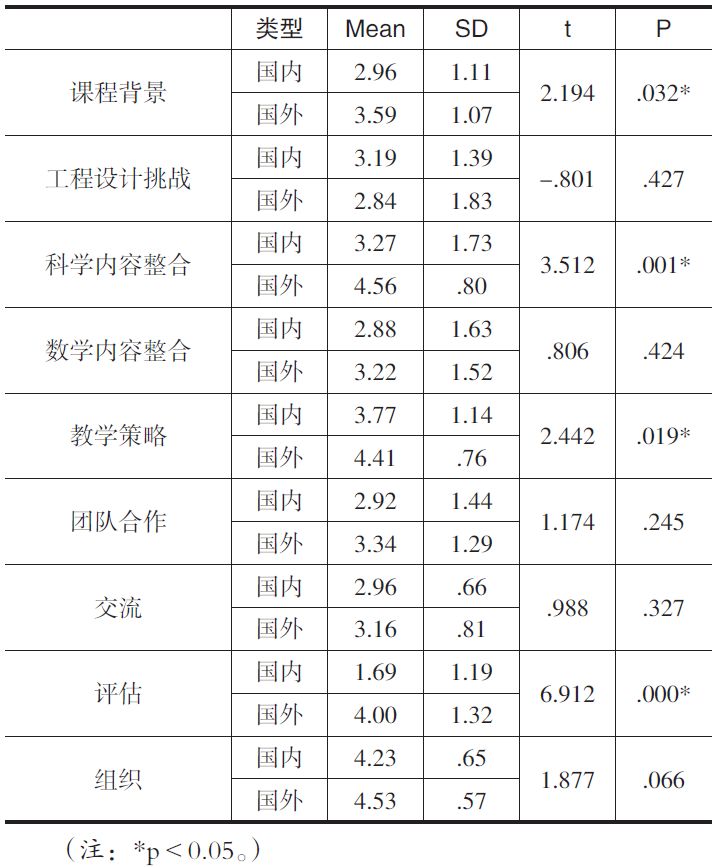
2. Research Discussion
Given the significant differences in the course context, integration of scientific content, teaching strategies, and assessment dimensions between domestic and foreign STEM courses, this study further statistically analyzed the coding results of domestic and foreign STEM courses in these four dimensions’ evaluation criteria (presented in percentage form) to explore the deeper reasons for the differences between the two, as shown in Table 3.
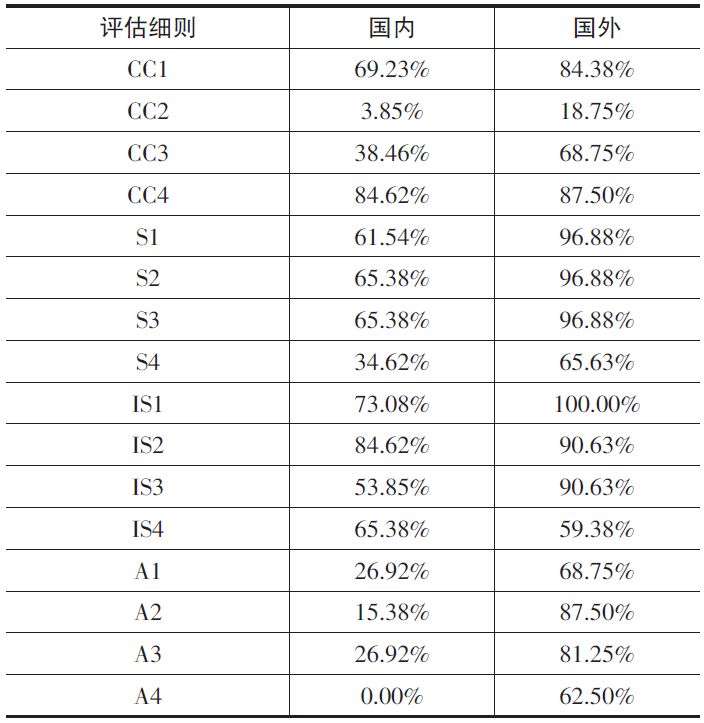
(1) Differences in Course Context
The course context mainly considers whether STEM courses can provide motivating and engaging problem situations, allowing students to conduct activities based on personal knowledge and experience in real contexts. Further analysis of the performance of domestic and foreign STEM courses in each evaluation criterion reveals that the significant difference in scores is primarily due to whether the problem situation “involves contemporary background and challenges.” 68.75% of American STEM courses can incorporate global, social, and natural environmental issues or challenges when constructing contexts, whereas only 38.46% of domestic courses can reflect this evaluation criterion. A good problem situation not only needs to restore the essence of the real world but should also have the teaching intention of broadening students’ horizons and expanding their perspectives. Analysis of the positioning of problem situations in domestic and foreign STEM course cases from personal, regional, and social levels reveals significant differences between the two (see Figures 1 and 2). In domestic STEM course cases, over 50% of the courses position problem situations at the personal level, lacking the teaching intention of “how to use what you have learned to make the world a better place”; while in foreign STEM course cases, over 70% of the courses can construct problem situations from a regional or social level, opening a window for students toward the world and the future. For example, in the field of biology, domestic STEM courses focus more on students’ learning about biodiversity, such as understanding the ecological characteristics of ducks and identifying different plant species; whereas American STEM courses can construct problem situations with a more open perspective, such as exploring the biological communities of deep-sea hydrothermal vents, whether it is possible to grow potatoes on Mars, and coronary artery blockage repair surgery. These problem situations involving contemporary background and challenges help broaden students’ horizons and perspectives, thereby cultivating their sense of social mission and responsibility.
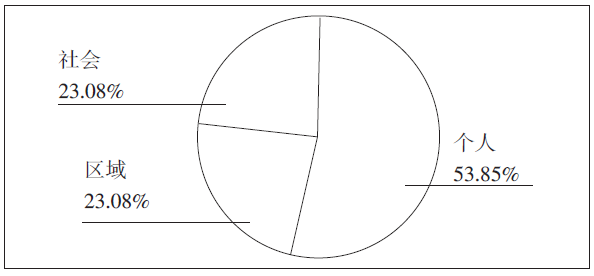
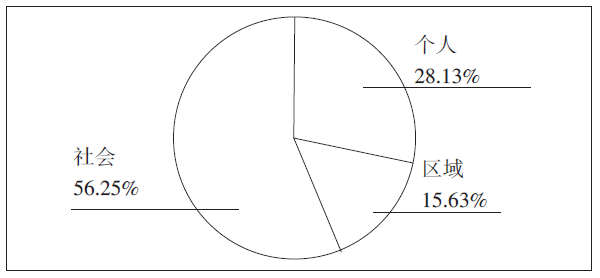
(2) Differences in Integration of Scientific Content
STEM courses emphasize multidisciplinary integration, of which integration of scientific content is an important representation. The integration of scientific content mainly considers whether STEM courses can promote students’ learning of scientific concepts and scientific thinking through scientific inquiry activities, thereby deepening their understanding of the natural world. Statistical results show that foreign STEM courses lead domestic ones by 1.29 points in this dimension, which is closely related to their emphasis on scientific learning. Over 90% of foreign course samples can integrate scientific knowledge in their teaching designs to promote students’ understanding of scientific concepts. Due to the predominance of subject-based teaching in China and the lack of clear STEM education standards, interdisciplinary integration is more challenging. The concept of maker education aligns closely with STEM education and is thus considered an important breakthrough for promoting STEM education in China. As the main carrier of maker education, technologies such as 3D printing, open-source hardware (like Arduino, Raspberry Pi), and some programming software (like Scratch, Mixly) have become the technical support for domestic STEM courses. Analysis reveals that over 50% of domestic STEM course samples are related to software and hardware applications, with only about 60% of courses able to integrate scientific knowledge. While the integration of technology itself aligns with the interdisciplinary characteristics of STEM, overemphasizing technological applications while neglecting students’ exploration of the essence of science contradicts the philosophy of STEM education.
The essence of science lies in understanding the natural world, and scientific inquiry simulates the genuine exploratory process of scientists. Through analyzing 32 foreign STEM sample cases, scientific inquiry can be divided into two categories: investigative research and experimental research. Investigative research refers to a planned and purposeful understanding of the actual situation of the research subject and analyzing the research materials; experimental research refers to a research paradigm that collects direct data and ultimately establishes causal relationships between variables by controlling relevant factors. Figure 3 outlines the main steps of both. Foreign STEM courses guide students to simulate authentic scientific research activities through the “true problems, true inquiry, true solutions” process, thereby cultivating students’ scientific awareness, scientific literacy, and scientific spirit. Unlike American STEM courses that emphasize authentic scientific experiences, domestic STEM courses lack openness, often adopting fixed solutions or operational steps to ensure students achieve correct results or standard answers. To some extent, this is one of the significant reasons why domestic students score high in academic performance, but it also limits students’ exploration and verification of the inquiry process and results. Since both domestic and foreign STEM course samples include the teaching of “Newton’s Second Law,” this knowledge point can be used as a reference to compare and analyze the differences in designing scientific inquiry activities. Given that Newton’s Second Law is an important principle established based on experiments, both domestic and foreign courses focus on exploring the relationship between acceleration and force and mass through experiments. However, the teaching methods differ significantly; domestically, the experimental inquiry is based on the lecture method, where students investigate the relationship between acceleration and net force while keeping mass constant based on teacher prompts. In contrast, foreign courses boldly adopt a trial-and-error method, where the teacher does not initially prompt students to control mass but provides hints based on the issues present in the experimental data after students encounter failures. This approach is closer to the authentic exploratory process of scientists and is crucial for helping students understand the essence of science and scientific practice, as well as for cultivating students’ critical thinking.
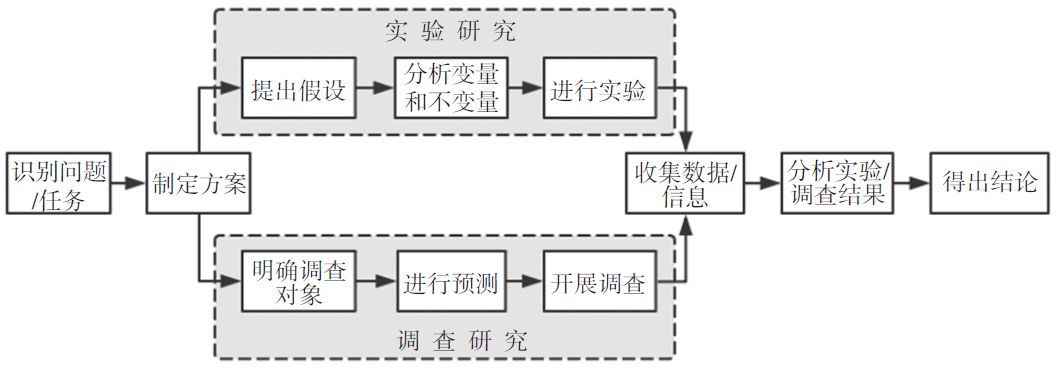 Figure 3 Steps of Two Types of Scientific Inquiry in Foreign STEM Courses
Figure 3 Steps of Two Types of Scientific Inquiry in Foreign STEM Courses
(3) Differences in Teaching Strategies
Teaching strategies are an important component of instructional design, which are the strategies that teachers develop for implementation under specific teaching objectives. Comparisons reveal that the main reasons for the significant differences in scores between domestic and foreign STEM courses in the teaching strategies dimension are “student-centered” and “argumentation strategies.” Nearly 100% of foreign STEM course cases include “student-centered” brainstorming or hands-on practice activities, while this is only reflected in 73.08% of domestic course cases. STEM courses emphasize the cultivation of students’ abilities, encouraging students to have more autonomy and freedom to express themselves. Analysis shows that domestic STEM courses mainly adopt task-driven teaching methods, where teachers guide students to engage in practical activities with a series of tasks that have a difficulty gradient. Under clear task requirements, the resulting outputs are often similar, which fails to meet the needs of students’ personalized development. In contrast, foreign STEM courses emphasize guiding students to engage in scientific inquiry and engineering practice activities through a series of progressively layered steps. The “5E instructional model” and “engineering design cycle” are the main teaching models adopted in American STEM courses, fully reflecting the principle of “student-centered.” The 5E model guides students in autonomous inquiry through five stages: Engagement, Exploration, Explanation, Elaboration, and Evaluation (Bybee et al., 2006). The engineering design cycle primarily includes stages of problem identification, solution design, prototype creation, testing, and improvement, supporting students in achieving an iterative process from need to design (Teachengineering, 2019). American STEM courses effectively integrate the steps of the “5E instructional model” and the “engineering design cycle,” providing a structured approach for conducting “student-centered” practical activities.
Drawing conclusions based on evidence is a significant feature of American STEM courses, with nearly 90% of foreign STEM course samples employing argumentation strategies, while this is only reflected in about 50% of domestic STEM course samples. Argumentation strategies emphasize providing evidence for claims through data analysis, truly achieving “reasoned and substantiated.” In recent years, with the continuous development and integration of big data technology, computational science, and artificial intelligence, the learning ecological environment is gradually transitioning from digitalization to data-based. Data plays a crucial role in the development of students’ multiple intelligences and the formation of core competencies (Committee on K-12 Engineering Education et al., 2009). In the engineering field, design choices must be supported by data, such as requiring students to test material temperature changes in both hot and cold environments when designing spacesuit materials. In scientific inquiry, data serves as a reliable basis for supporting conclusions, such as in the case “Vibrant Lakes,” where students analyze and interpret data collected on the temperature and dissolved oxygen concentration of Payette Lake to conclude that winter lake water temperature increases with depth while dissolved oxygen levels decrease. Therefore, appropriately employing argumentation strategies not only cultivates students’ reasoning and argumentation abilities but also enhances their data literacy.
(4) Differences in Assessment
Assessment aims to determine whether teaching has achieved the expected learning objectives and is generally divided into preparatory assessment, formative assessment, and summative assessment. Compared to traditional classroom paper-and-pencil tests, STEM education focuses more on students’ performance and thoughts during the learning process. The flexibility and non-uniqueness of scientific and engineering practice activities make it challenging to define assessment criteria, which has become the most confusing and troublesome issue for science teachers when designing STEM courses. Statistical results show that fewer than 30% of domestic STEM course samples consider assessment, which is also the reason for the significant gap in assessment dimension scores compared to foreign STEM courses. Analysis reveals that American STEM courses exhibit a diversified approach to assessment, emphasizing the combination of formal and informal assessments, as detailed in Table 4. In preparatory assessments before class, teachers evaluate students’ learning situations through surveys, questions, or interviews, including prior knowledge reserves and understanding of background knowledge. In process assessments, teachers pay close attention to students’ views on problems and interactions among students. Science notebooks are commonly used by American STEM teachers as a basis for process assessment, recording important process information during practical activities, such as discoveries, questions, ideas, steps, solutions, sketches, data, explanations, discussions, and conclusions (Campbell et al., 2003). By analyzing the initial information, observational records, and discussion conclusions presented in science notebooks, teachers can assess students’ understanding of problems, mastery of knowledge, and level of participation in activities. In terms of summative assessment, in addition to evaluating conventional content such as model design, oral and written reports, American STEM teachers also employ unique strategies to gain insights into students’ thoughts, such as using the CER (Claim-Evidence-Reasoning) method to have students write experimental statements based on evidence and employing the ORID focus discussion method (Objective-Reflective-Interpretive-Decisional) to assess students’ in-depth thinking about course content, as well as using the 321 strategy to help students reflect on three gains, two questions about design improvements, and one good practice experienced during the process.
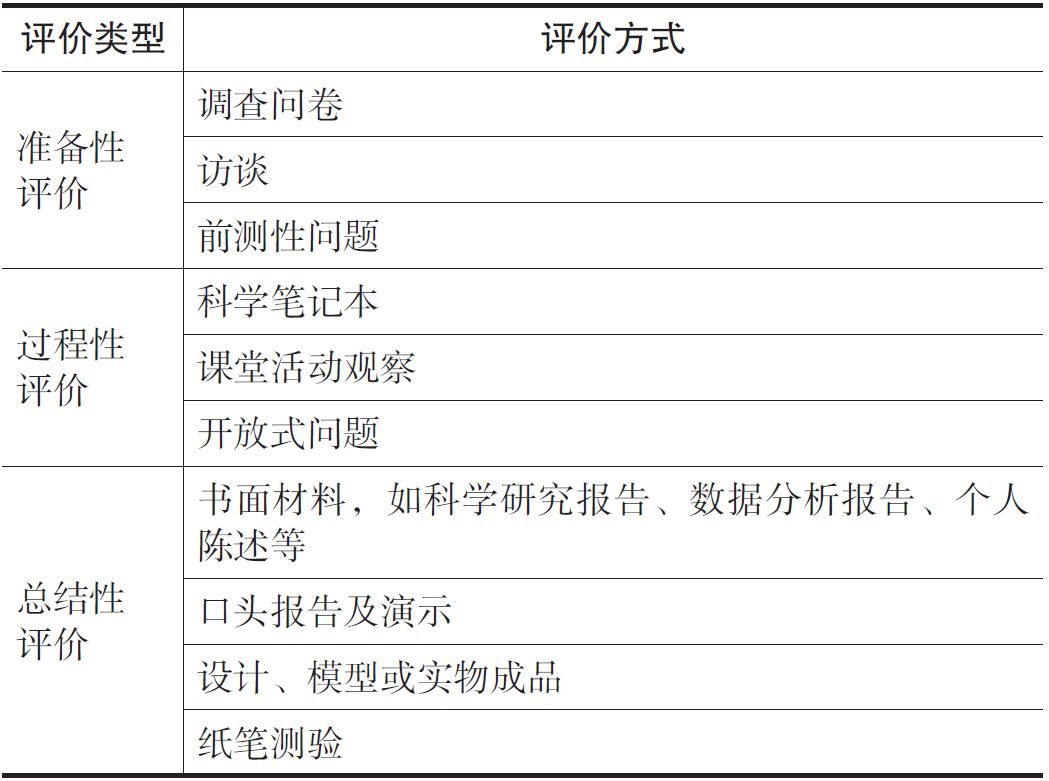
By comparing and analyzing the performance of domestic and foreign STEM courses across various dimensions, it can be observed that American STEM courses are better at creating socially relevant and challenging problem situations, and they also have unique experiences in the integration of scientific content, teaching strategies, and assessment. Based on the analysis results, the following recommendations can be made for the design of STEM courses in China:
1. Enhance responsiveness to social issues and cultivate students’ sense of social responsibility
Situating learning in real-world contexts is a practical path to connect students’ learning with the real world, and creating contexts to drive scientific and engineering practice activities is the core essence of STEM courses. Most domestic STEM courses abstract problems that students need to solve from contexts, providing students with clear themes and objectives from the perspective of individual learning. However, real-world problems are closely tied to social contexts and contain certain “noise.” Teachers need to create problem situations that broaden students’ perspectives, guiding them to think about how to use what they have learned to solve real-world problems and challenges, thereby expanding students’ life perspectives. A good problem situation not only relates to students themselves but also provides opportunities for students to express their creativity and social responsibility at the regional or social level. Therefore, when constructing STEM course contexts, teachers should carefully select problem situations to help students understand the relationship between individuals and society, consider the opportunities and challenges faced by human society, and fulfill their responsibilities and obligations in the information society. Currently, some international organizations, such as the National Academy of Engineering (NAE) in the United States, have proposed several socially-oriented research challenges, such as creating clean energy, recycling resources, preventing nuclear terrorism, and enhancing virtual reality (National Academic of Engineering, 2008). Teachers should broaden their focus from individual and community issues to global ones when designing STEM course contexts, cultivating students’ sense of social responsibility against the backdrop of global opportunities and challenges.
2. Encourage effective failure and create authentic scientific experiences
Domestic STEM courses lack integration of scientific content, not only incorporating few scientific concepts but also lacking scientific inquiry processes. Over-reliance on software and hardware technology leads domestic teachers to overlook students’ learning and understanding of scientific concepts. American STEM teachers guide students to follow scientific inquiry processes through investigative and experimental research, which has high reference value for improving the integration of scientific content. To improve the current situation of scientific content integration, on one hand, teachers should reduce the reliance of STEM courses on software and hardware technology, designing investigative or experimental activities starting from real-life contexts. For example, in the “automatically tracking fan case,” students can first explore the impact of different blade shapes and numbers on airflow through experimentation and then design the fan structure model. This approach effectively combines software and hardware technology while achieving effective integration of scientific inquiry and engineering design. On the other hand, teachers should emphasize the complete process of scientific inquiry to create authentic scientific experiences for students. Due to constraints of class size, teaching duration, and activity venues, many domestic teachers adopt preset solutions or operational steps to ensure students achieve correct results or standard answers. While this approach allows students to reach scientific facts in the shortest path, it does not provide authentic scientific experiences. Science does not have the shortest path; experiencing failures is a compulsory course for scientists in scientific experiments. Genuine scientists find ways to overcome errors in failures. Therefore, appropriately “delegating power” to students and encouraging them to simulate real scientific inquiry activities through effective failures is crucial for cultivating students’ scientific awareness, scientific literacy, and scientific spirit.
3. Enrich student-centered strategies and amplify students’ cognitive processes
One of the biggest challenges facing K-12 STEM education is the lack of general guidelines or models for teachers on how to use STEM integration methods in classrooms (Wang et al., 2011). Currently, most STEM teachers in China employ a combination of lecturing and practice, guiding students to master necessary knowledge and skills by completing progressively challenging tasks. While this method can enhance students’ memory of factual information, it often fails to promote meaningful learning and does not achieve a qualitative transformation from “teacher-centered” to “student-centered.” STEM courses emphasize being “student-centered,” which hinges on whether they can promote students’ active participation in the learning process (Land et al., 2012). Currently, a task-driven approach is widely adopted in China, combined with teachers’ guidance, to promote cooperative learning, but the overall teaching strategy remains relatively weak. American STEM courses provide a feasible learning path by integrating the 5E instructional model and the engineering design cycle’s progressive steps. Under the guidance of the 5E instructional model and the engineering design cycle, teachers cleverly incorporate storytelling, modeling, role-playing, brainstorming, field research, and experimental workstations to stimulate students’ intrinsic motivation for learning, fully reflecting the principle of “student-centered.” In addition, American STEM courses use argumentation strategies to guide students in conducting classroom research based on evidence, which not only helps amplify students’ cognitive processes but also significantly promotes the development of students’ critical thinking. Therefore, STEM teaching in China should enrich student-centered strategies and amplify students’ cognitive processes.
4. Focus on informal assessments to promote the development of students’ comprehensive abilities
Assessment is an important part of teaching, significant for evaluating students’ abilities, optimizing curriculum instruction, and promoting student development. Analysis of domestic STEM course cases reveals that, aside from a few courses that employ student self-assessment, teacher feedback, or group competitions for assessment activities, most courses do not consider assessment. STEM courses emphasize students’ process performance and cognitive development, but student-centered scientific inquiry and engineering practice activities have considerable openness and flexibility, making assessment difficult to implement. Drawing on the design experience of American STEM courses, informal assessment is a key breakthrough. Informal assessment can help teachers more accurately evaluate students’ mastery of scientific process skills and content knowledge, uncovering more hidden issues among students (Peters, 2008). When conducting assessments in STEM courses, teachers are advised to focus on the following aspects: enrich informal assessment tools, such as science notebooks, classroom observations, and open-ended questions; deepen informal assessment content, allowing and encouraging students to record, narrate, and communicate their understanding of knowledge, progress made, and existing difficulties in various forms—verbally, in writing, or through charts—thus fully understanding students’ growth and cognitive development; and adopt practical strategies to focus on externalizing and guiding students’ thinking during informal assessments, flexibly employing some strategies to direct students’ discussion or establish norms for reasoning and argumentation, such as the CER method, ORID focus discussion method, and the 321 strategy.
In the context of the increasing popularity of STEM education, developing high-quality STEM courses to guide teaching has become urgent. The United States is the first country to implement STEM education and has accumulated rich practical experience in systematically and comprehensively implementing STEM education policies and practices. To analyze the problems existing in China’s STEM courses, this study evaluates and compares the quality of domestic and foreign STEM courses based on authoritative STEM course integration evaluation tools from abroad. The results reveal significant shortcomings in domestic STEM courses compared to foreign STEM courses in the dimensions of course context, integration of scientific content, teaching strategies, and assessment. Drawing on the design experiences of American STEM courses, this study proposes four recommendations: enhance responsiveness to social issues and cultivate students’ sense of social responsibility; encourage effective failure and create authentic scientific experiences; enrich student-centered strategies and amplify students’ cognitive processes; and focus on informal assessments to promote the development of students’ comprehensive abilities. Since this study selected a collection of frontline teaching cases evaluated at a specific academic exchange seminar as domestic analysis samples, there is a lack of representativeness. Future research is hoped to uncover more authoritative STEM course cases and conduct larger-scale quality evaluation studies to make contributions to advancing STEM course construction in China.
References:
[1] Fu Qian, Liu Pengfei (2016). From Verification to Creation: Research on Application Models of STEM Education in Primary and Secondary Schools. China Educational Technology, (4):71-78.
[2] Yang Yanjun, Rao Feifei (2019). Case Study and Enlightenment of Interdisciplinary Integrated STEM Curriculum Development: A Case Study of the Mars Education Project STEM Curriculum in the United States. Research on Educational Technology, 40(2):113-122.
[3] Yu Shengquan, Hu Xiang (2015). STEM Education Philosophy and Interdisciplinary Integration Models. Open Education Research, (4):13-22.
[4] Zhong Baichang, Zhang Lifang (2014). The Role of the “Transformation Equation” in the Reform of STEM Education in the United States and Its Implications. China Educational Technology, (4):18-24.
[5] Zhou Pengqin, Xu Chang, Zhang Yun et al. (2016). Analysis of American Science Curriculum Textbooks from the STEM Perspective: A Case Study of FOSSK 5th Grade Science Textbook. China Educational Technology, (5):25-32.
[6] Bybee, R. W., Taylor, J. A., & Gardner, A. et al. (2006). The BSCS 5E Instructional Model: Origins and Effectiveness. Colorado Springs, Co: BSCS: 88-98.
[7] Campbell, B., & Fulton, L. (2003). Science Notebooks: Writing about Inquiry. Heinemann, NH: Portsmouth.
[8] Committee on K-12 Engineering Education, Katehi, L., & Pearson, G. et al. (2009). Engineering in K-12 Education: Understanding the Status and Improving the Prospects. Washington, DC: National Academies Press.
[9] Guzey, S. S., Moore, T. J., & Harwell, M. (2016). Building Up STEM: An Analysis of Teacher-Developed Engineering Design-based STEM Integration Curricular Materials. Journal of Pre-College Engineering Education Research (J-PEER), 6(1): 1-19.
[10] Labov, J. B., Reid, A. H., & Yamamoto, K. R. (2010). Integrated Biology and Undergraduate Science Education: A New Biology Education for the Twenty-First Century? CBE-Life Sciences Education, 9(1):10-16.
[11] Land, S. M., Hannafin, M. J., & Oliver, K. (2012). Student-Centered Learning Environments: Foundations, Assumptions, and Design. Theoretical Foundations of Learning Environments (2nd Edition). Taylor & Francis: 3-25.
[12] National Academy of Engineering (2008). Grand Challenges for Engineering. [2019-12-04]. http://www.engineeringchallenges.com.
[13] Parker, C. E., Stylinski, C. D., & Bonney, C. R. et al. (2015). Examining the Quality of Technology Implementation in STEM Classrooms: Demonstration of an Evaluative Framework. Journal of Research on Technology in Education, 47(2):105-121.
[14] Peters, E. (2008). Assessing Scientific Inquiry. Science Scope, 31(5):27-33.
[15] Selwitz, J. L., Ahring, B., & Garcia-Perez, M. et al. (2018). Engineering an Associate Degree-Level STEM Workforce Education Curriculum. Community College Journal of Research and Practice, 42(6): 405-421.
[16] Teachengineering (2019). Engineering Design Process. [2019-12-04]. https://www.teachengineering.org/k12engineering/designprocess.
[17] Wang, H. H., Moore, T. J., & Roehrig, G. H. et al. (2011). STEM Integration: Teacher Perceptions and Practice. Journal of Pre-College Engineering Education Research (J-PEER), 1(2):1-13.
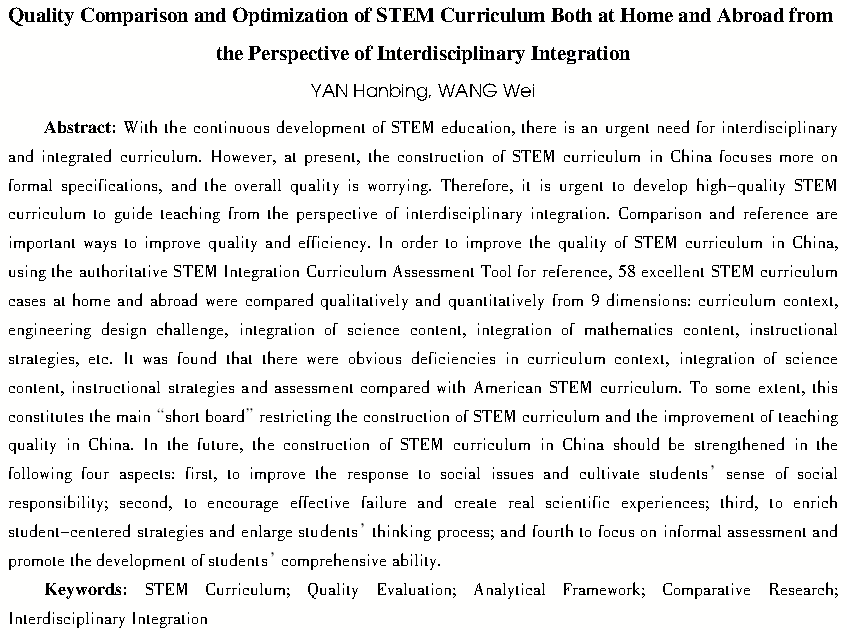
The cover image comes from the internet